Evaluating the Early-Age Crack Induction in Advanced Reinforced Concrete Pavement Using Partial Surface Saw-Cuts
Abstract
1. Introduction
2. Concept of ARCP
3. Cracking Behavior of CRCP Sections in Belgium
4. Finite Element Modeling
4.1. Model Geometry
4.2. Thermo-Mechanical Properties
4.3. Boundary Conditions
4.4. Elements Used in FE Modeling
4.5. Cracking Model Used in FE Modeling
5. Validation of the FE Model
6. Reinforcement Layout Design of ARCP Segment
7. Results and Discussion
8. Summary of Findings and Conclusions
Author Contributions
Funding
Acknowledgments
Conflicts of Interest
References
- Safiuddin, M.; Kaish, A.; Woon, C.-O.; Raman, S.N. Early-age cracking in concrete: Causes, consequences, remedial measures, and recommendations. Appl. Sci. 2018, 8, 1730. [Google Scholar] [CrossRef]
- Guo, S.; Dai, Q.; Hiller, J. Investigation on the freeze-thaw damage to the jointed plain concrete pavement under different climate conditions. Front. Struct. Civ. Eng. 2018, 12, 227–238. [Google Scholar] [CrossRef]
- Jung, Y.S.; Zollinger, D.G.; Ehsanul, B.M. Improved Mechanistic–Empirical Continuously Reinforced Concrete Pavement Design Approach with Modified Punchout Model. Transp. Res. Rec. 2012, 2305, 32–42. [Google Scholar] [CrossRef]
- Lee, S.W.; Stoffels, S.M. Effects of excessive pavement joint opening and freezing on sealants. J. Transp. Eng. 2003, 129, 444–450. [Google Scholar] [CrossRef]
- Saghafi, B.; Hassani, A.; Noori, R.; Bustos, M.G. Artificial neural networks and regression analysis for predicting faulting in jointed concrete pavements considering base condition. Int. J. Pavement Res. Technol. 2009, 2, 20–25. [Google Scholar]
- Vennapusa, P.K.; White, D.J. Field assessment of a jointed concrete pavement foundation treated with injected polyurethane expandable foam. Int. J. Pavement Eng. 2015, 16, 906–918. [Google Scholar] [CrossRef]
- Yao, J.-L.; Weng, Q.-h. Causes of longitudinal cracks on newly rehabilitated jointed concrete pavements. J. Perform. Constr. Facil. 2012, 26, 84–94. [Google Scholar] [CrossRef]
- Darter, M.I.; LaCoursiere, S.A.; Smiley, S.A. Structural Distress Mechanisms in Continuously Reinforced Concrete Pavement. Transp. Res. Rec. 1979, 715, 1–7. [Google Scholar]
- Hall, K.; Dawood, D.; Vanikar, S.; Tally, R., Jr.; Cackler, T.; Correa, A.; Deem, P.; Duit, J.; Geary, G.; Gisi, A. Long-Life Concrete Pavements in Europe and Canada; The National Academies of Sciences, Engineering, and Medicine: Washington, DC, USA, 2007. [Google Scholar]
- Kohler, E.; Roesler, J. Crack Width Determination in Continuously Reinforced Concrete Pavements. In Proceedings of the Second International Conference on Accelerated Pavement Testing, Minneapolis, MN, USA, 26–29 September 2004. [Google Scholar]
- Kohler, E.; Roesler, J. Active crack control for continuously reinforced concrete pavements. Transp. Res. Rec. 2004, 1900, 19–29. [Google Scholar] [CrossRef]
- Ren, D. Optimisation of the Crack Pattern in Continuously Reinforced Concrete Pavements. Ph.D. Thesis, Technische Universiteite Delft, Delft, The Netherlands, 2015. [Google Scholar]
- Ren, D.; Houben, L.; Rens, L.; Beeldens, A. Active Crack Control for Continuously Reinforced Concrete Pavements in Belgium Through Partial Surface Notches. Transp. Res. Rec. 2014, 2456, 33–41. [Google Scholar] [CrossRef]
- Zollinger, D.G.; Buch, N.; Xin, D.; Soares, J. Performance of CRCP Volume 6-CRCP Design, Construction, and Performance; FHWA-RD-97-151; FHWA: Washington, DC, USA, 1998.
- De Winne, P.; De Backer, H.; Depuydt, S. Active Crack Control in Continuously Reinforced Concrete Pavements (CRCP). In High Tech Concrete: Where Technology and Engineering Meet; Springer: Berlin/Heidelberg, Germany, 2018; pp. 1389–1397. [Google Scholar]
- Kang, Y.-J.; Park, J.; Yoon, K.-Y.; Han, S.-Y. Experimental study on fatigue strength of continuously reinforced concrete pavements. Mag. Concr. Res. 2004, 56, 605–615. [Google Scholar] [CrossRef]
- Oh, H.J.; Cho, Y.K.; Kim, S.-M. Experimental evaluation of crack width movement of continuously reinforced concrete pavement under environmental load. Constr. Build. Mater. 2017, 137, 85–95. [Google Scholar] [CrossRef]
- Oh, H.J.; Cho, Y.K.; Seo, Y.; Kim, S.-M. Experimental analysis of curling behavior of continuously reinforced concrete pavement. Constr. Build. Mater. 2016, 128, 57–66. [Google Scholar] [CrossRef]
- Oh, H.J.; Cho, Y.K.; Seo, Y.; Kim, S.-M. Experimental evaluation of longitudinal behavior of continuously reinforced concrete pavement depending on base type. Constr. Build. Mater. 2016, 114, 374–382. [Google Scholar] [CrossRef]
- Ren, D.; Houben, L.J.; Rens, L. Monitoring Early-Age Cracking of Continuously Reinforced Concrete Pavements on the E17 at Ghent (Belgium). In Sustainable Construction Materials 2012; ASCE: Reston, VA, USA, 2013; pp. 30–41. [Google Scholar]
- Rens, L. Continuously Reinforced Concrete-State-of-the-Art in Belgium. In Proceedings of the 11th International Symposium on Concrete Roads, Padua, Italy, 11–13 September 2019. [Google Scholar]
- Rens, L.; Beeldens, A. The Behaviour of CRCP in Belgium: Observation and Measurement of Crack Pattern, Bond and Thermal Movement. In Proceedings of the 7th International DUT-Workshop on Design and Performance of Sustainable and Durable Concrete Pavements, Seville, Spain, 10–11 October 2010. [Google Scholar]
- Rens, L.; Winne, P.; Beeldens, A. Continuously Reinforced Concrete Pavement: New Development for a Sustainable Concept. In Proceedings of the Belgian Road Congress, Liege, Belgium, 29 July 2016. [Google Scholar]
- Verhoeven, K. Cracking and Corrosion in Continuously Reinforced Concrete Pavements. In Proceedings of the Fifth International Conference on Concrete Pavement Design and Rehabilitation, West Lafayette, IN, USA, 20–22 April 1993. [Google Scholar]
- Choi, S.; Ha, S.; Won, M.C. Horizontal cracking of continuously reinforced concrete pavement under environmental loadings. Constr. Build. Mater. 2011, 25, 4250–4262. [Google Scholar] [CrossRef]
- Kashif, M.; De Winne, P.; Naseem, A.; Iqbal, N.; De Backer, H. Three Dimensional Finite Element Model for Active Crack Control in Continuously Reinforced Concrete Pavement. In Proceedings of the 9th International Conference on Maintenance and Rehabilitation of Pavements—Mairepav9; Springer: Cham, Switzerland, 2020. [Google Scholar]
- Kashif, M.; Naseem, A.; Iqbal, N.; Winne, P.D.; De Backer, H. Numerical Evaluation of Early-Age Crack Induction in Continuously Reinforced Concrete Pavement with Different Saw-Cut Dimensions Subjected to External Varying Temperature Field. Appl. Sci. 2020, 11, 42. [Google Scholar] [CrossRef]
- Mirsayar, M.; Zollinger, D. Factors influencing stresses and movements in continuously reinforced concrete pavements—A review. Eng. Solid Mech. 2018, 6, 67–82. [Google Scholar] [CrossRef]
- Ryu, S.W.; Choi, P.; Choi, S.; Won, M.C. Improvements of Full-Depth Repair Practices for Distresses in Continuously Reinforced Concrete Pavement. Transp. Res. Rec. 2013, 2368, 102–113. [Google Scholar] [CrossRef]
- Selezneva, O.; Darter, M.; Zollinger, D.; Shoukry, S. Characterization of transverse cracking spatial variability: Use of long-term pavement performance data for continuously reinforced concrete pavement design. Transp. Res. Rec. 2003, 1849, 147–155. [Google Scholar] [CrossRef]
- Suh, Y.-C.; Hankins, K.D.; McCullough, B.F. Early-Age Behavior Continuously Reinforced Concrete Pavement and Calibration the Failure Prediction Model in the CRCP-7 Program; Center for Transportation Research: Austin, TX, USA, 1992. [Google Scholar]
- Suh, Y.-C.; McCullough, B.F.; Hankins, K.D. Development and application of randomness index for continuously reinforced concrete pavement. Transp. Res. Rec. 1991, 1307, 136–142. [Google Scholar]
- Chen, D.-H.; Lin, H.-H.; Sun, R. Field performance evaluations of partial-depth repairs. Constr. Build. Mater. 2011, 25, 1369–1378. [Google Scholar] [CrossRef]
- Chorzepa, M.G.; Johnson, C.; Durham, S.; Kim, S.S. Forensic Investigation of Continuously Reinforced Concrete Pavements in Fair and Poor Condition. J. Perform. Constr. Facil. 2018, 32, 04018031. [Google Scholar] [CrossRef]
- Citir, N.; Durham, S.A.; Chorzepa, M.G.; Sonny Kim, S. Investigation of Factors Affecting Distresses on Continuously Reinforced Concrete Pavement using Ground Penetrating Radar. J. Perform. Constr. Facil. 2020, 34, 04020027. [Google Scholar] [CrossRef]
- Kim, K.; Han, S.; Tia, M.; Greene, J. Optimization of parameters affecting horizontal cracking in continuously reinforced concrete pavement (CRCP). Can. J. Civ. Eng. 2019, 46, 634–642. [Google Scholar] [CrossRef]
- Kim, S.-M.; Cho, Y.K.; Lee, J.H. Advanced reinforced concrete pavement: Concept and design. Constr. Build. Mater. 2020, 231, 117130. [Google Scholar] [CrossRef]
- Kim, S.-M.; Won, M.; Frank McCullough, B. Numerical modeling of continuously reinforced concrete pavement subjected to environmental loads. Transp. Res. Rec. 1998, 1629, 76–89. [Google Scholar] [CrossRef]
- Kim, S.-M.; Won, M.C. Horizontal cracking in continuously reinforced concrete pavements. Struct. J. 2004, 101, 784–791. [Google Scholar]
- McCullough, B.F.; Dossey, T. Considerations for high-performance concrete paving: Recommendations from 20 years of field experience in Texas. Transp. Res. Rec. 1999, 1684, 17–24. [Google Scholar] [CrossRef]
- Al-Qadi, I.L.; Elseifi, M. Mechanism and modeling of transverse cracking development in continuously reinforced concrete pavement. Int. J. Pavement Eng. 2006, 7, 341–349. [Google Scholar] [CrossRef]
- Kim, S.-M.; Won, M.C.; Frank McCullough, B. Three-dimensional analysis of continuously reinforced concrete pavements. Transp. Res. Rec. 2000, 1730, 43–52. [Google Scholar] [CrossRef]
- Sofi, M.; Lumantarna, E.; Mendis, P.; Zhong, A. Thermal Stresses of Concrete at Early Ages. J. Mater. Civ. Eng. 2019, 31, 04019056. [Google Scholar] [CrossRef]
- Ren, D.; Houben, L.; Rens, L. Cracking behavior of continuously reinforced concrete pavements in Belgium: Characterization of current design concept. Transp. Res. Rec. 2013, 2367, 97–106. [Google Scholar] [CrossRef]
- DIANA FEA BV. DIANA User’s Manual Release 10.3; DIANA FEA BV: Delft, The Netherlands, 2017. [Google Scholar]
- Choi, S.; Na, B.-U.; Won, M.C. Mesoscale analysis of continuously reinforced concrete pavement behavior subjected to environmental loading. Constr. Build. Mater. 2016, 112, 447–456. [Google Scholar] [CrossRef]
- Neville, A.M.; Brooks, J.J. Concrete Technology; Longman Scientific & Technical: London, UK, 1987. [Google Scholar]
- Byfors, J. Plain concrete at early ages. CBI Forsk 1980, 2, 465. [Google Scholar]
- Khan, A.A.; Cook, W.D.; Mitchell, D. Thermal properties and transient thermal analysis of structural members during hydration. Mater. J. 1998, 95, 293–303. [Google Scholar]
- Morabito, P. Thermal Properties of Concrete: Variations with the Temperature and During the Hydration Phase; Department of Civil Minining Engeneering: Milan, Italy, 2001. [Google Scholar]
- Saeed, M.K.; Rahman, M.K.; Baluch, M.H. Early age thermal cracking of mass concrete blocks with Portland cement and ground granulated blast-furnace slag. Mag. Concr. Res. 2016, 68, 647–663. [Google Scholar] [CrossRef]
- Emanuel, J.H.; Hulsey, J.L. Prediction of the thermal coefficient of expansion of concrete. Proc. J. Proc. 1977, 74, 149–155. [Google Scholar]
- Glasser, F. Chemical, mineralogical and Micro-structural Changes Occurring in Hydrated Slag-Cement Blends. Mater. Sci. Concr. 1991, 52, 41–82. [Google Scholar]
- Hendriks, M.A.; Rots, J. Finite Elements in Civil Engineering Applications: Proceedings the Third DIANA World Conference, Tokyo, Japan, 9–11 October 2002; CRC Press: Boca Raton, FL, USA, 2002. [Google Scholar]
- Narin, F.; Wiklund, O. Design of Slabs-on-Ground Regarding Shrinkage Cracking. 2012. Available online: http://publications.lib.chalmers.se/records/fulltext/165126.pdf (accessed on 11 July 2020).
- Faria, R.; Azenha, M.; Figueiras, J.A. Modelling of concrete at early ages: Application to an externally restrained slab. Cem. Concr. Compos. 2006, 28, 572–585. [Google Scholar] [CrossRef]
- Sofi, M.; Mendis, P.; Baweja, D.; Mak, S. Influence of ambient temperature on early age concrete behaviour of anchorage zones. Constr. Build. Mater. 2014, 53, 1–12. [Google Scholar] [CrossRef]
- Rots, J.G. Computational Modeling of Concrete Fracture. Ph.D. Thesis, Delft University of Technology, Delft, The Netherlands, September 1988. [Google Scholar]
- McCullough, B.F.; Treybig, H.J. Determining the Relationship of Variables in Deflection of Continuously-Reinforced Concrete Pavement. Highw. Res. Rec. 1966, 131, 65–86. [Google Scholar]
- Tsai, Y.J.; Wang, Z. Critical Assessment I-85 CRCP Crack Spacing Patterns and Their Implications for Long-Term Performance; Georgia Department of Transportation, Office of Research: Tbilisi, Georgia, 2014.
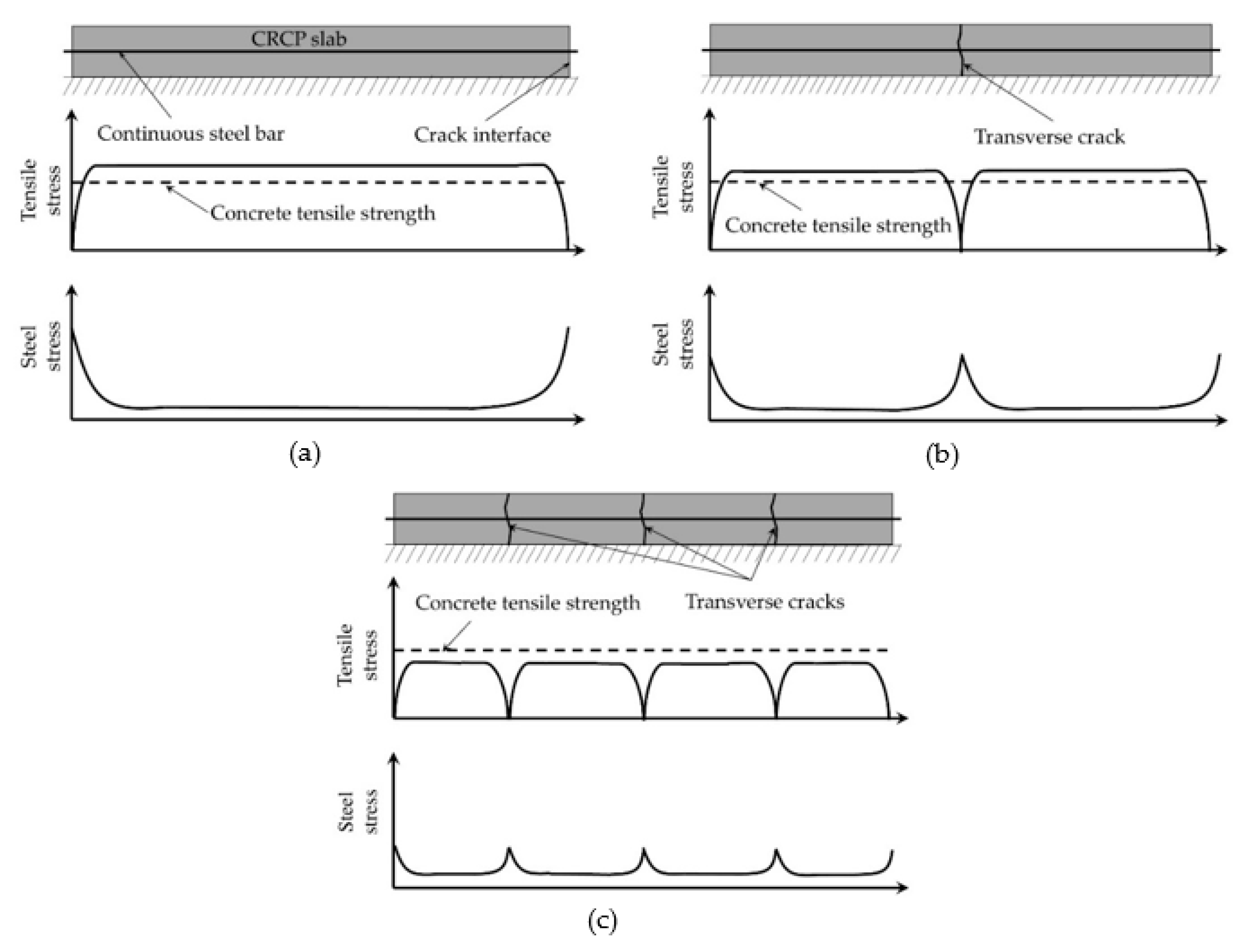
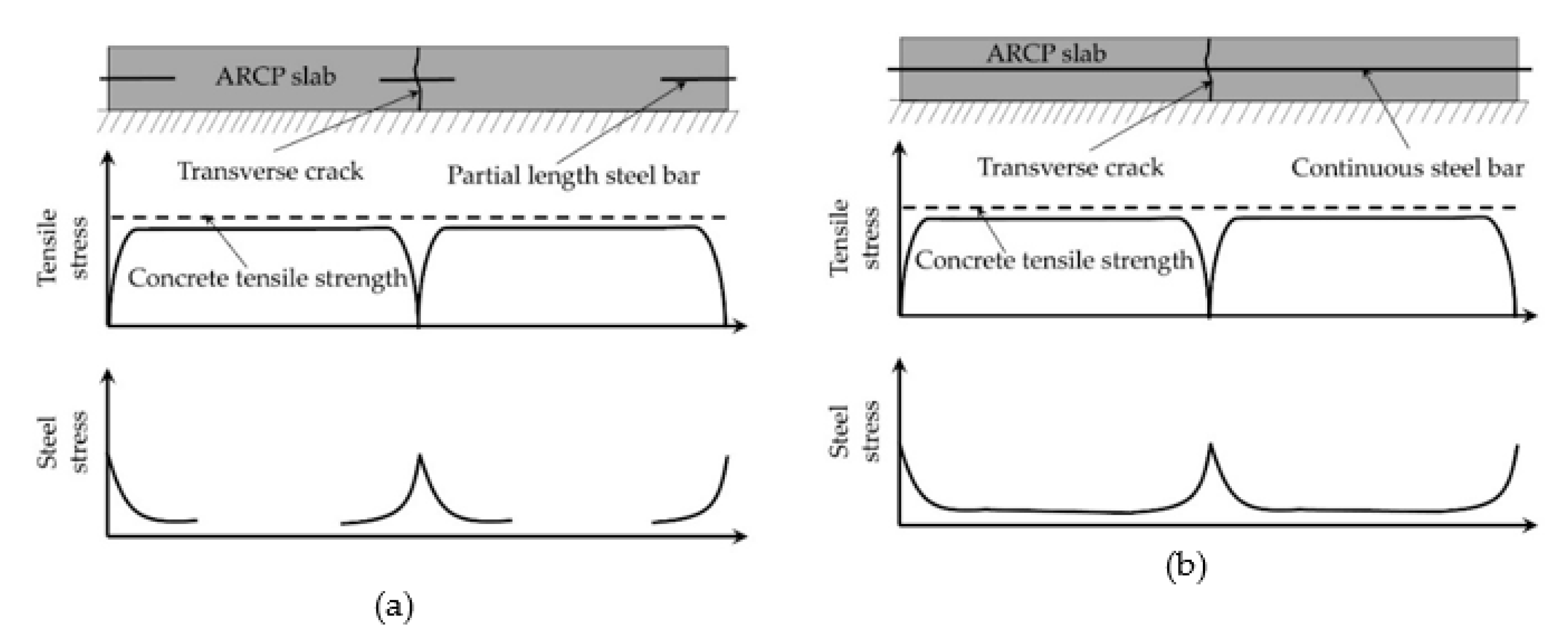

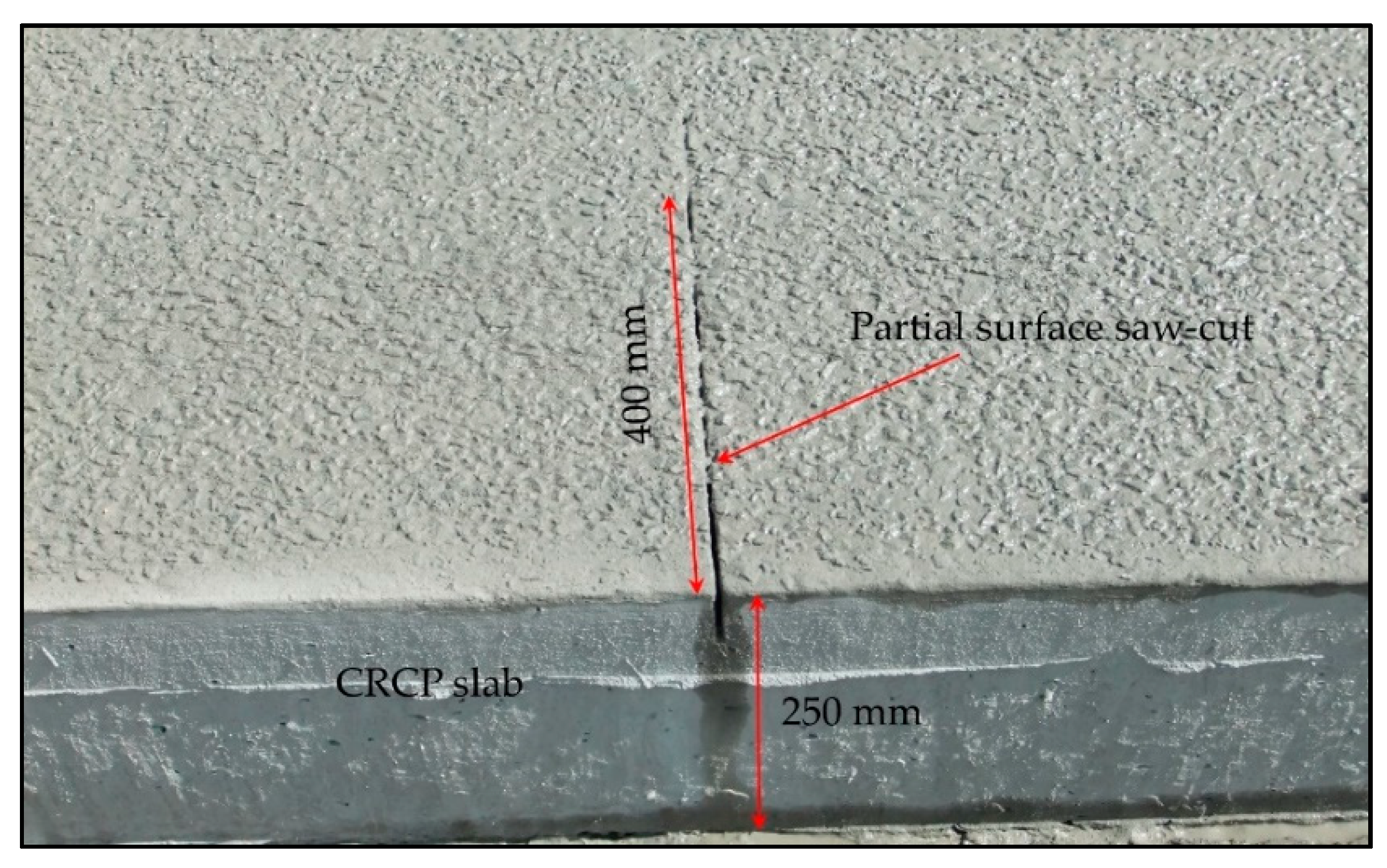
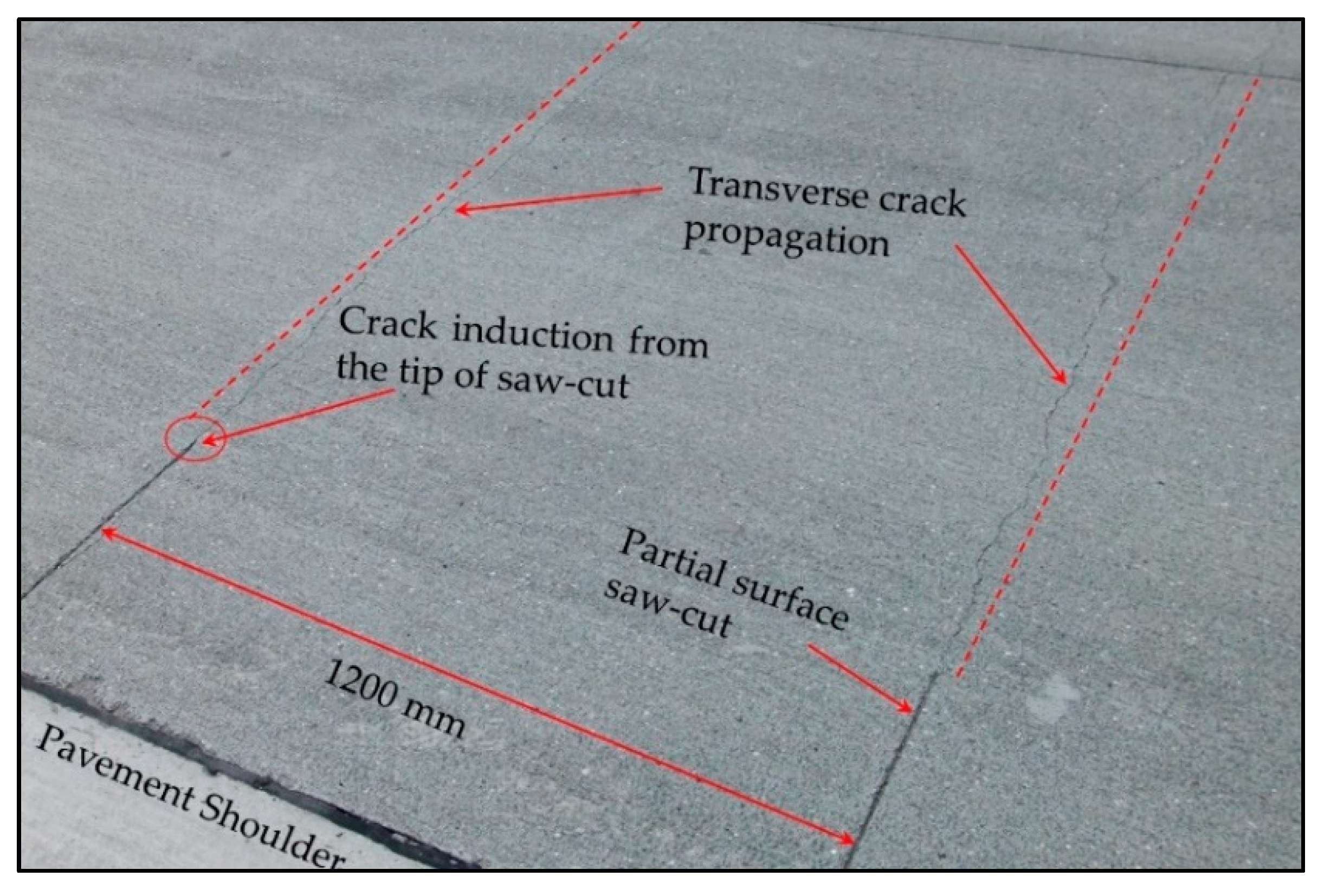
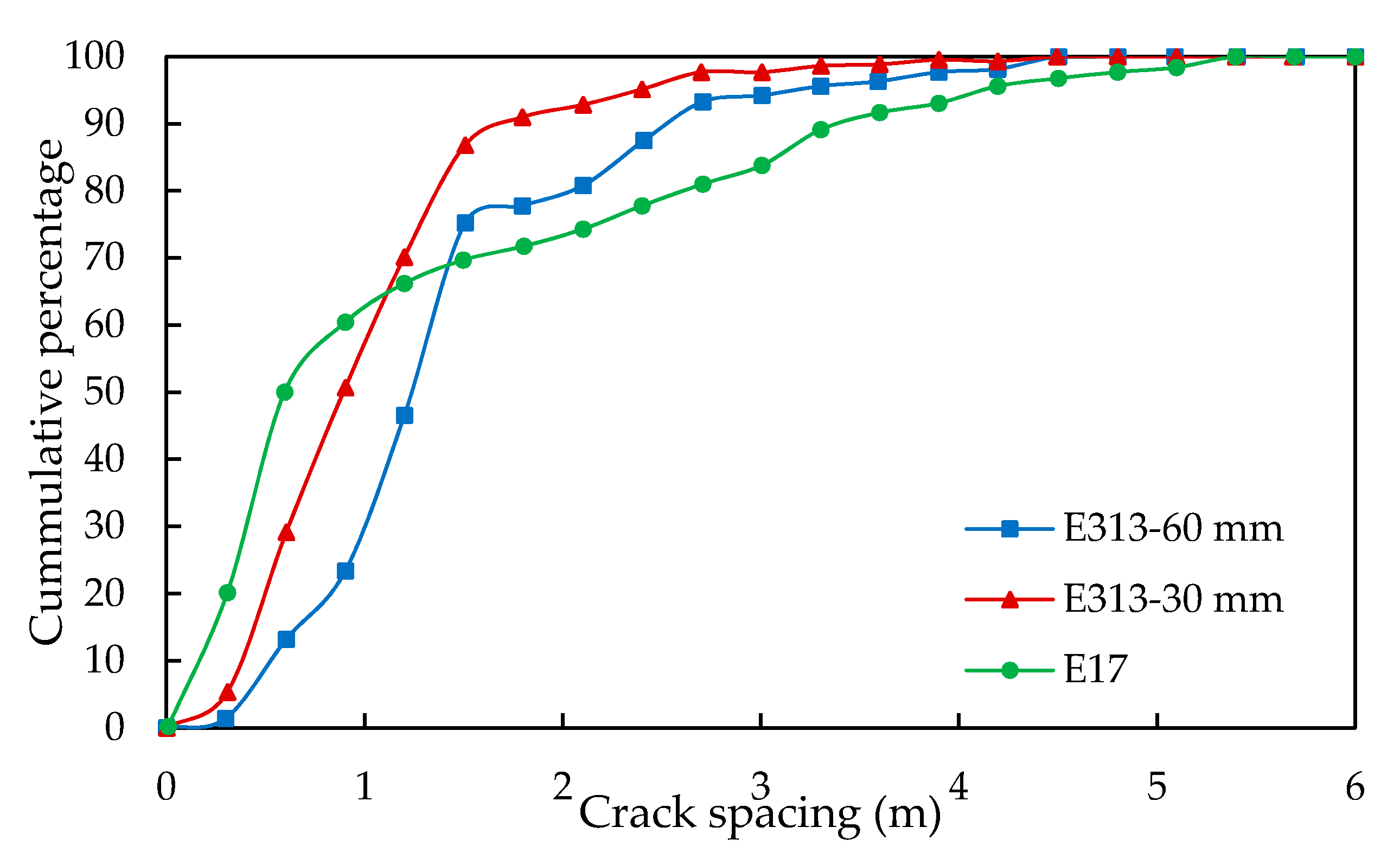


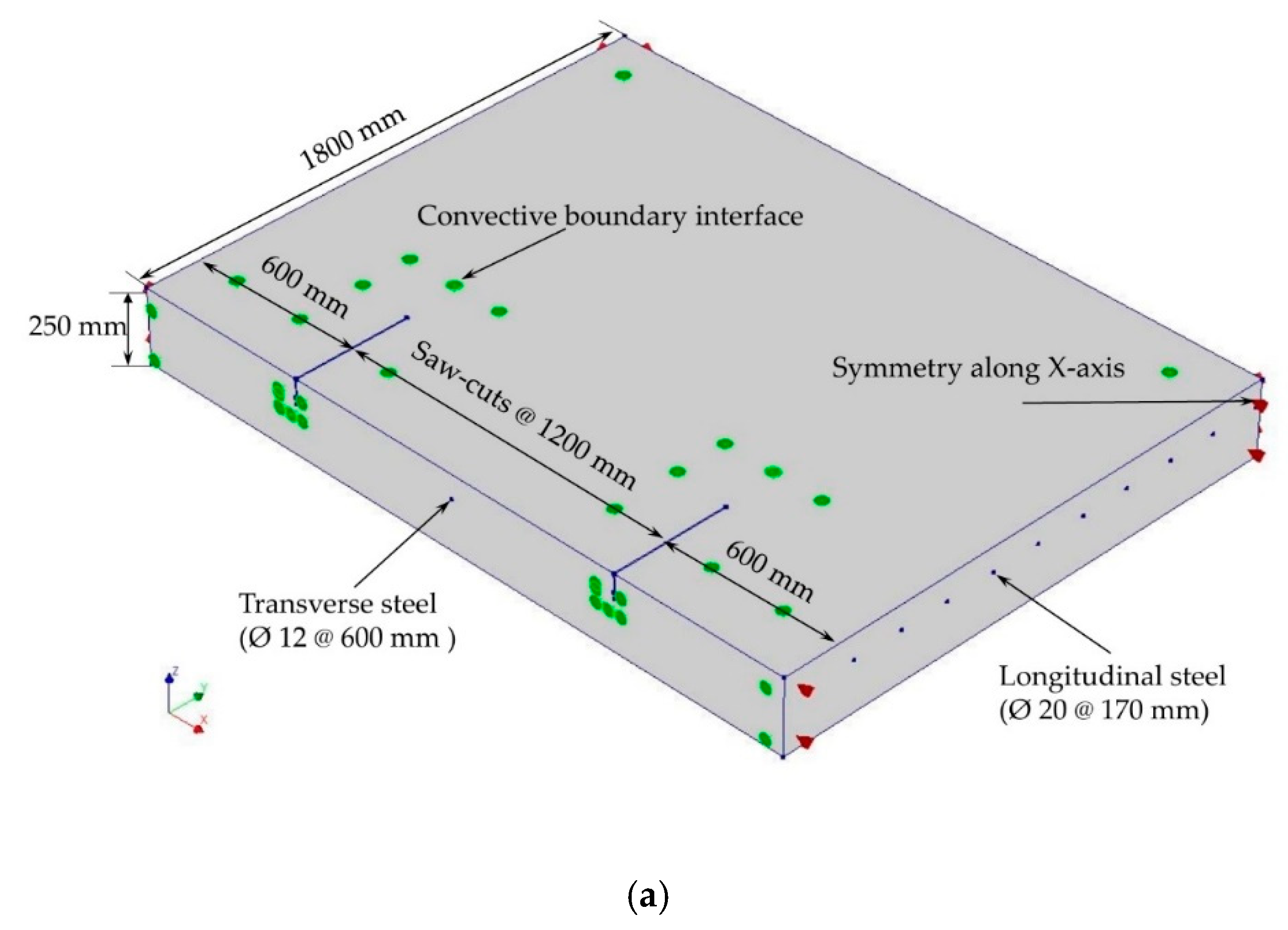
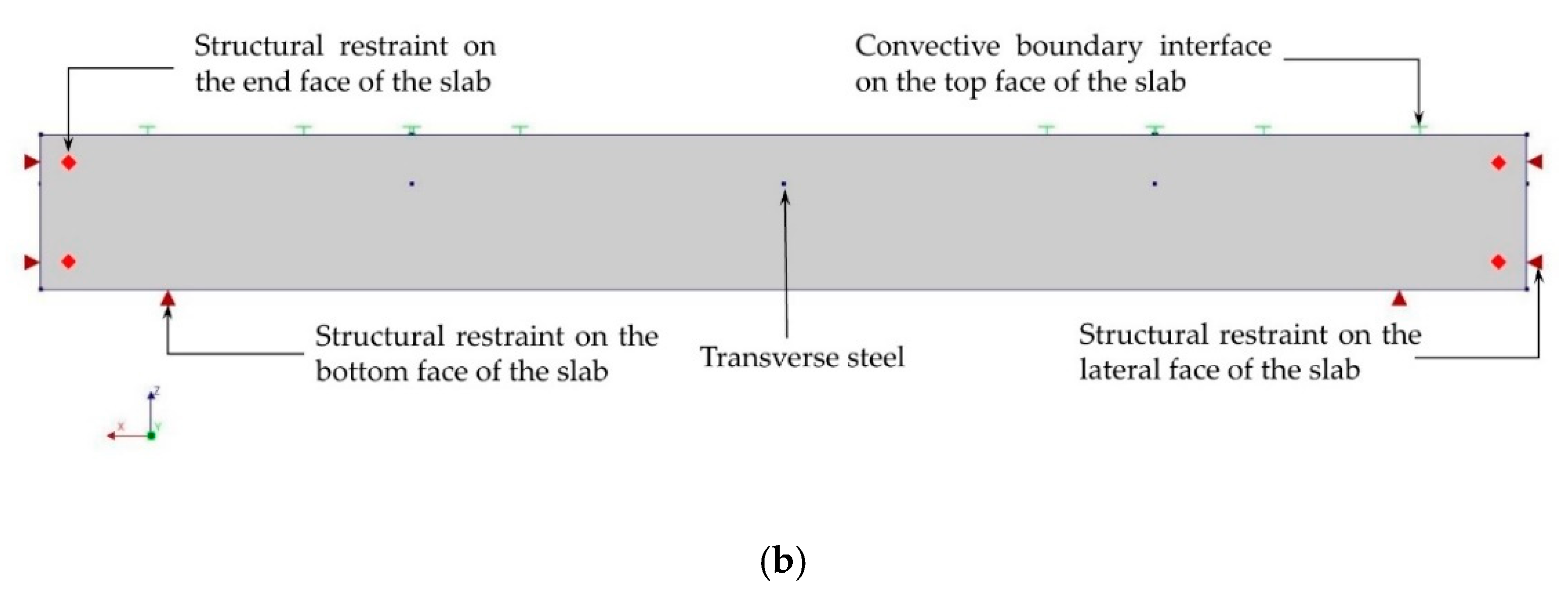

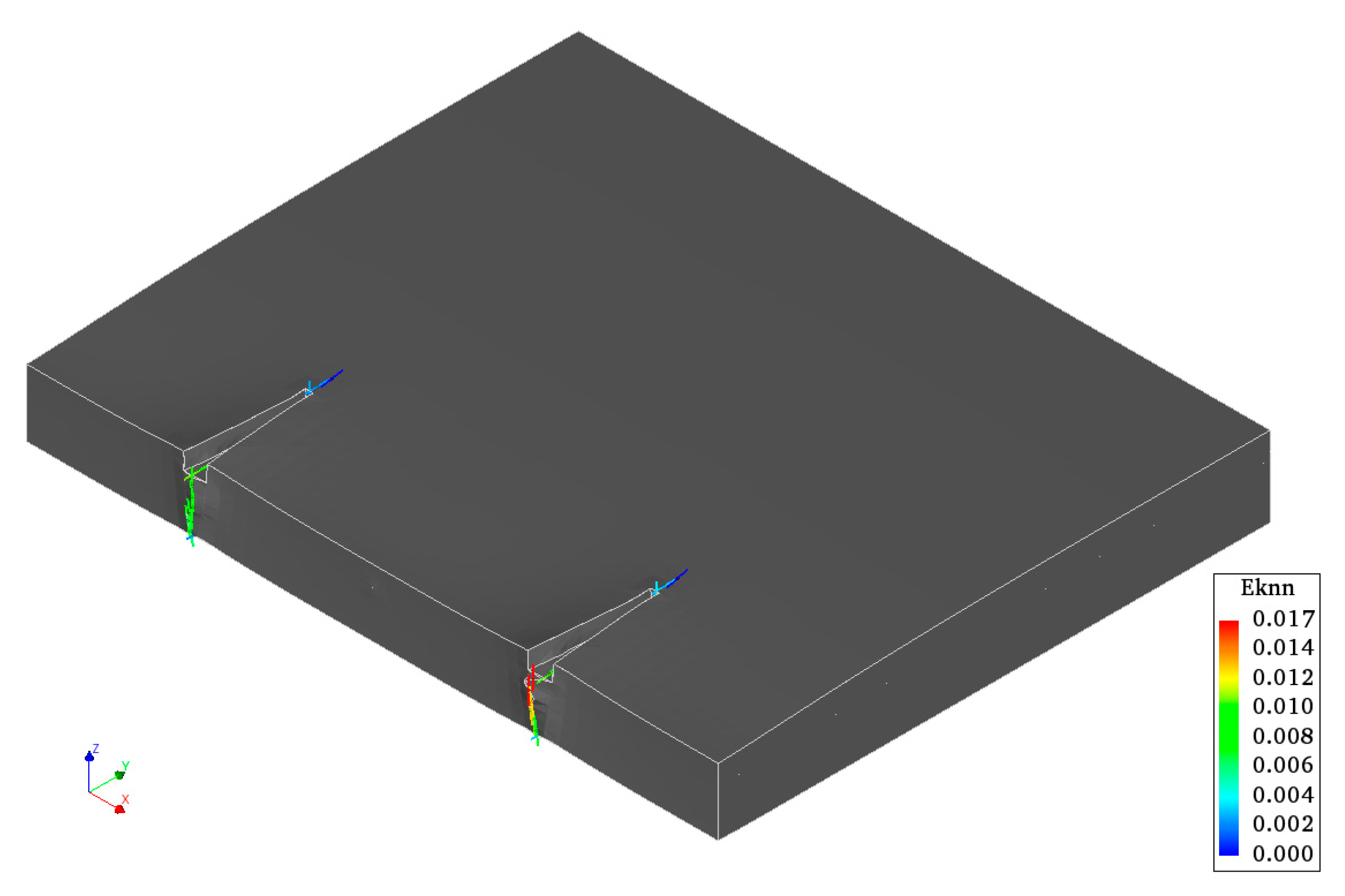
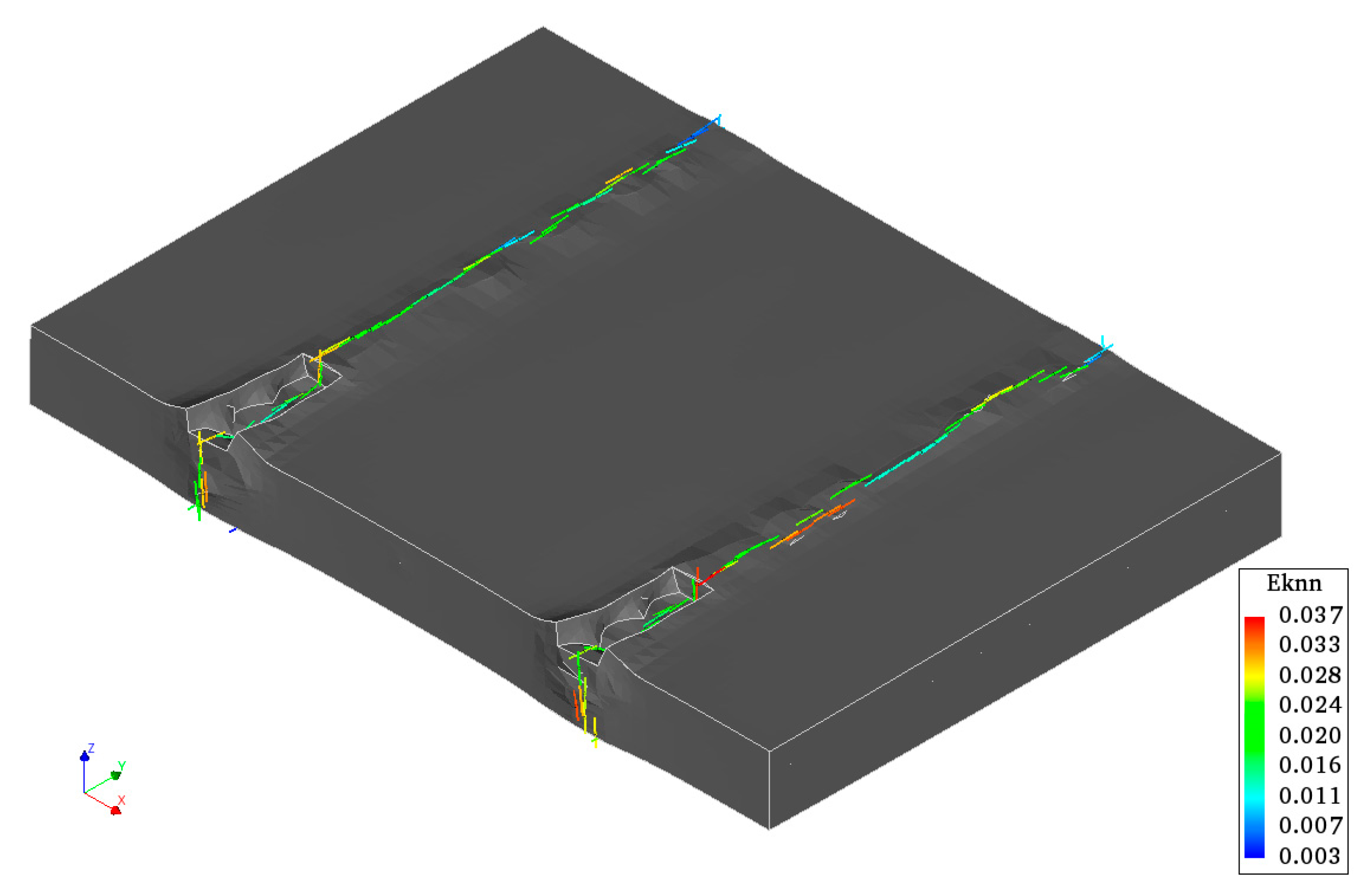
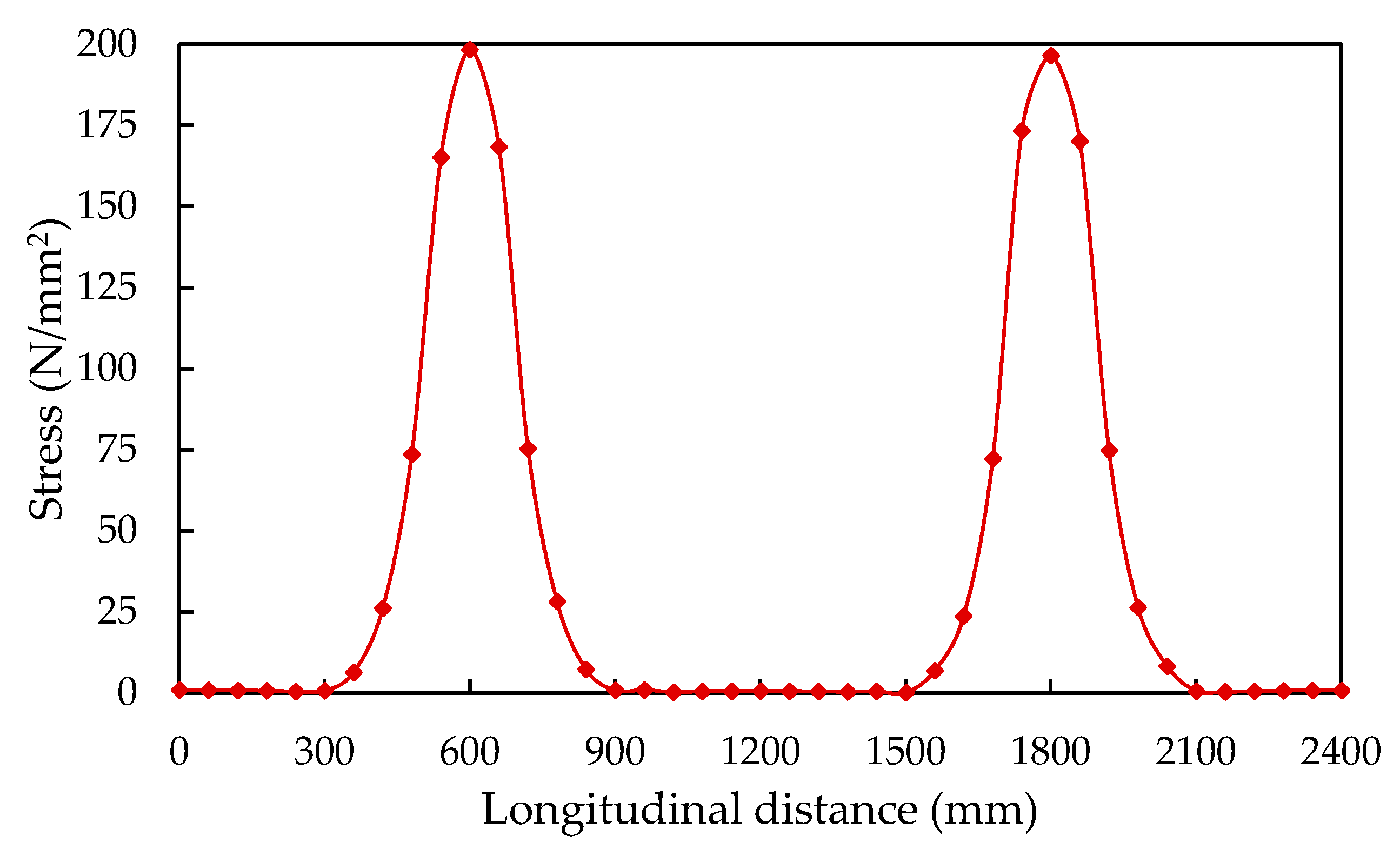

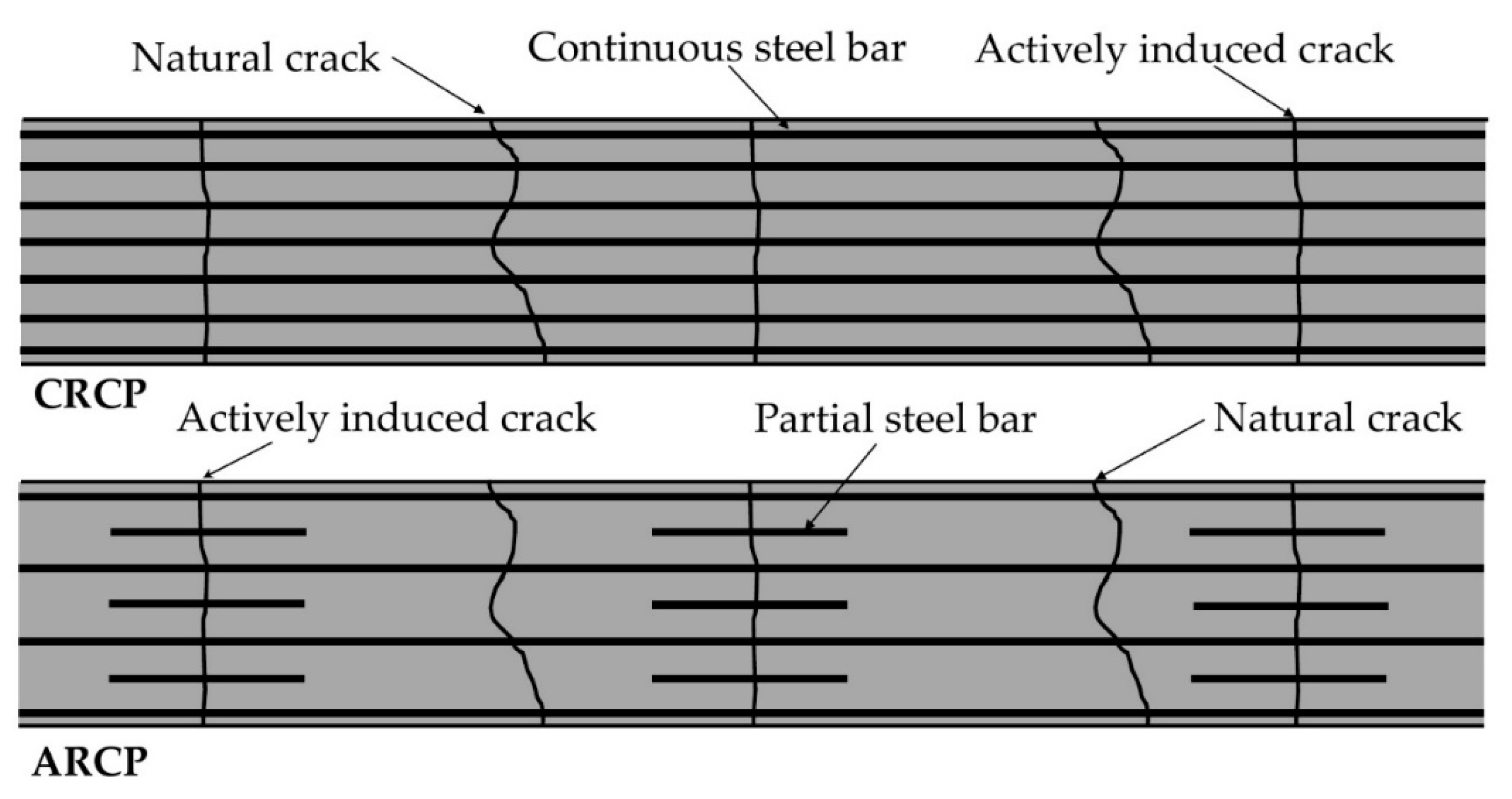
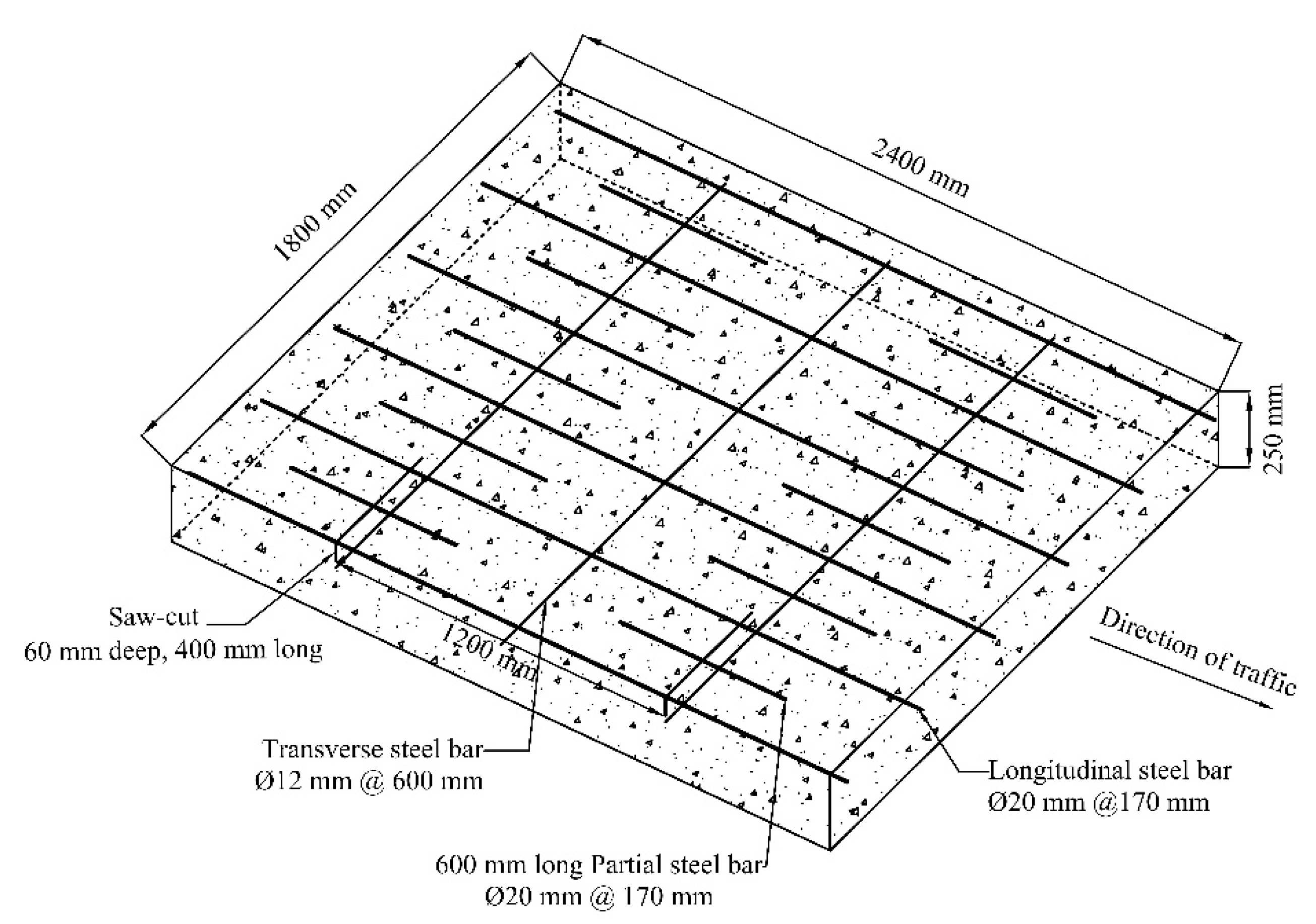

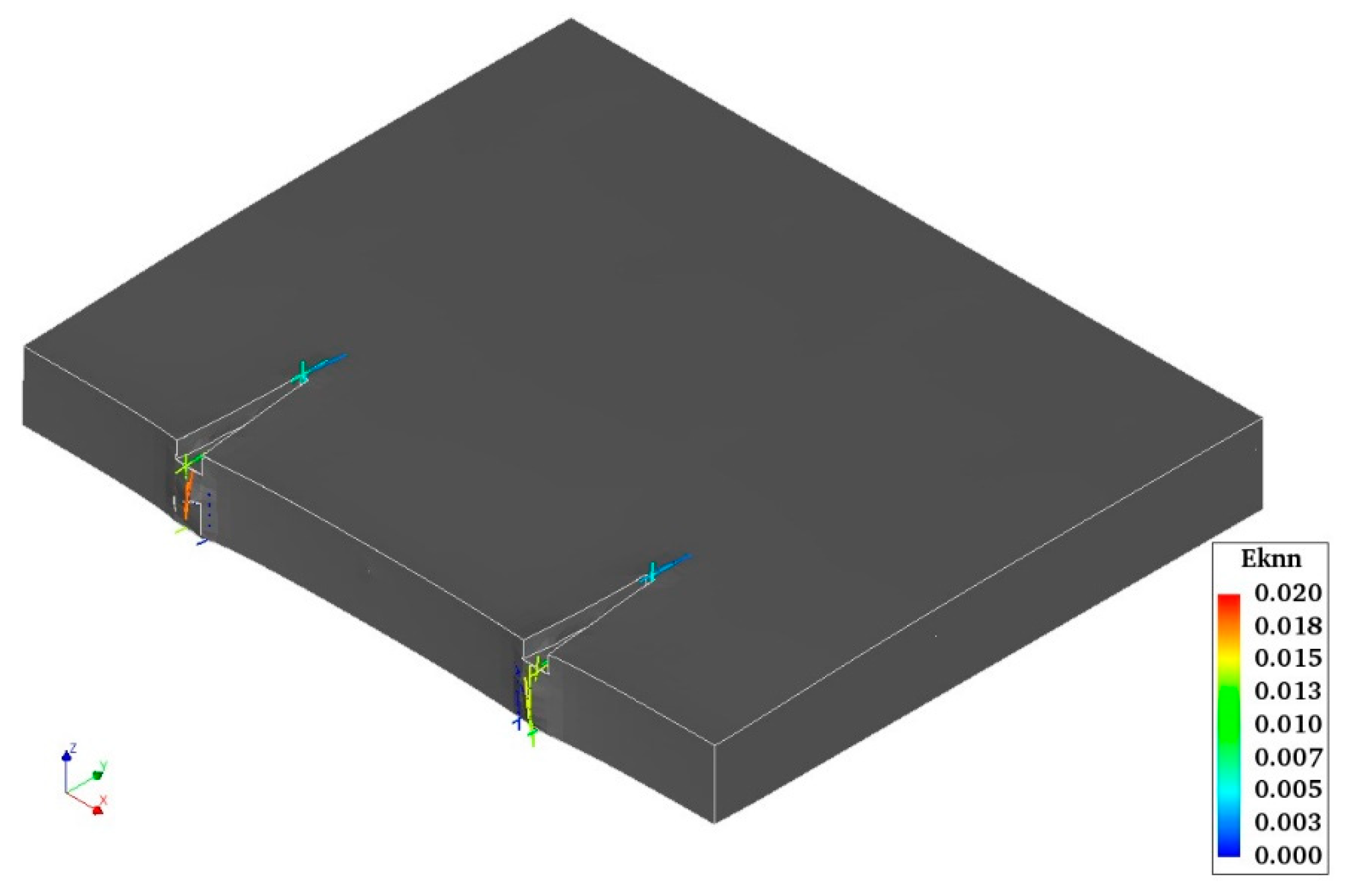
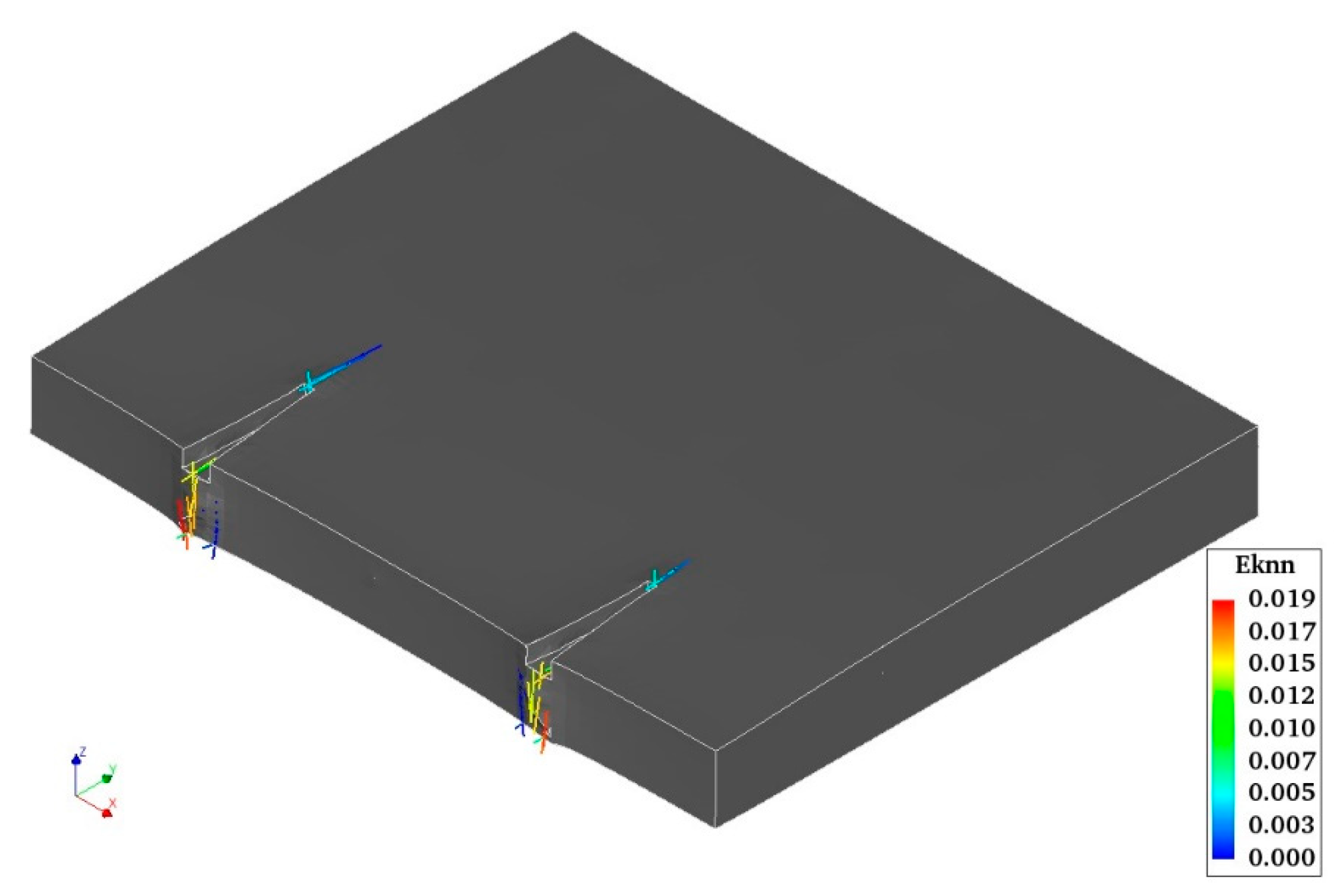


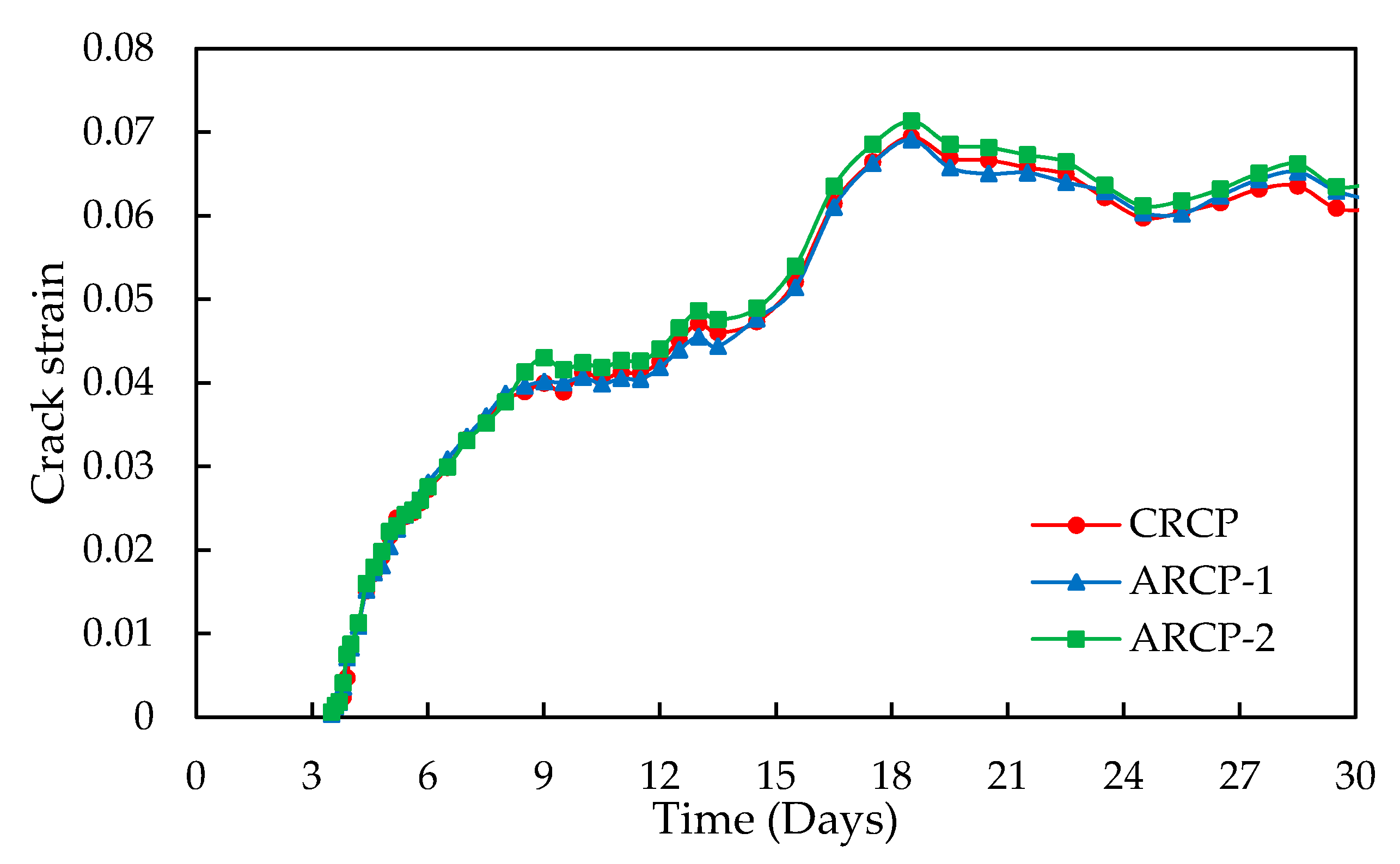
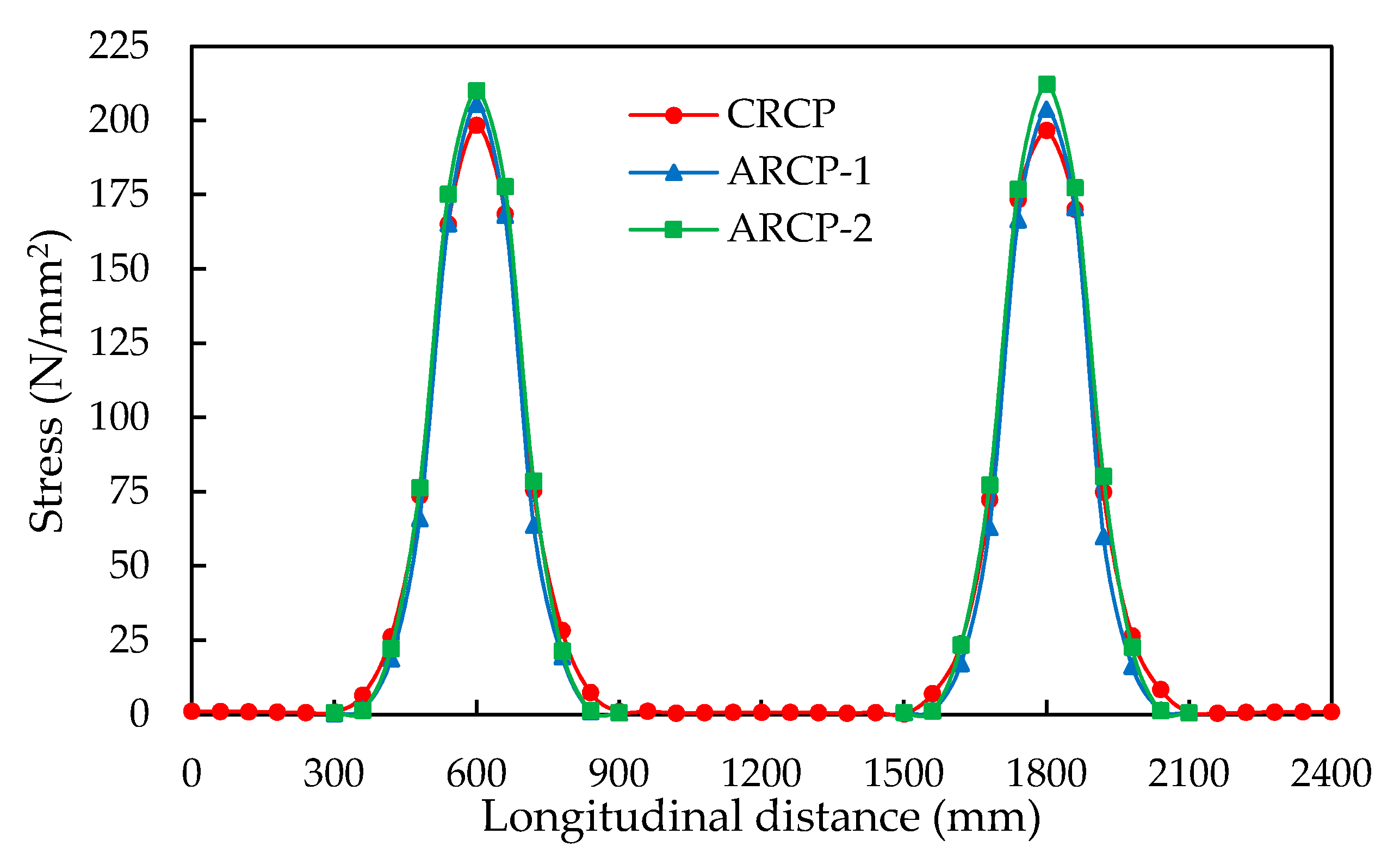
| Design Concept | Concept 1 | Concept 2 | Concept 3 |
|---|---|---|---|
| Time period | 1970–1981 | 1981–1995 | 1995–onwards |
| Longitudinal reinforcement | 0.85% (Ø18@150 mm) | 0.67% (Ø16@150 mm) | 0.75% (Ø20@170 mm) |
| Cover depth | 60 mm | 90 mm | 80 mm |
| Slab thickness | 200 mm | 200 mm | 230/250 mm |
| Asphalt interlayer | Yes, 60 mm | No | Yes, 50 mm |
| Road Section | Length (m) | Age (Days) | No. of Notches (N1) | No. of Cracks (N2) | No. of Cracks at Notches (N3) | Effectiveness of Notches N3/N1 (%) | Percentage of Cracks in Category by Distance to Nearest Notch (m) | |||
|---|---|---|---|---|---|---|---|---|---|---|
| 0 | 0–0.2 | 0.2–0.4 | 0.4–0.6 | |||||||
| 60 mm | 1100 | 4 | 897 | 193 | 191 | 21.3 | 98.9 | 0 | 0 | 1.1 |
| 1100 | 65 | 897 | 664 | 555 | 61.9 | 83.5 | 2.4 | 7.7 | 6.4 | |
| 1100 | 204 | 897 | 762 | 597 | 66.6 | 78.4 | 3.8 | 9.8 | 8.0 | |
| 1100 | 378 | 897 | 775 | 606 | 67.6 | 78.2 | 3.8 | 9.9 | 8.1 | |
| 500 | 123 | 422 | 417 | 245 | 58.1 | 58.7 | 9.4 | 15.9 | 16.0 | |
| 30 mm | 500 | 262 | 422 | 497 | 281 | 66.5 | 56.5 | 8.7 | 17.5 | 17.3 |
| 500 | 436 | 422 | 502 | 285 | 67.5 | 56.8 | 8.6 | 17.3 | 17.3 | |
| Concrete class | C40/50 |
| Aggregate type | Limestone |
| Coefficient of thermal expansion of concrete (1/°C) | 10.0 × 10−6 |
| Concrete thermal conductivity (W/m °C) | 2.7 |
| Concrete volumetric heat specific capacity (J/m3 °C) | 2.87 × 106 |
| Convection-radiation coefficient between concrete and air (W/m2 °C) | 7.55 |
| Input Parameters | Value |
|---|---|
| Ambient temperature (°C) | 20 |
| Notional size (mm) | 439 |
| Relative humidity (%) | 80 |
| Curing age (Days) | 3 |
| Steel Design | CRCP | ARCP-1 | ARCP-2 |
|---|---|---|---|
| Diameter of continuous steel bar (mm) | 20 | 20 | 20 |
| Length of continuous steel bar (mm) | 2400 | 2400 | 2400 |
| Rows of continuous steel bars | 11 | 6 | 4 |
| Continuous steel ratio (%) | 0.767 | 0.418 | 0.279 |
| Diameter of partial steel bar (mm) | - | 20 | 20 |
| Length of partial steel bar (mm) | - | 600 | 600 |
| Rows of partial steel bars | - | 5 | 7 |
| Steel ratio at crack inducer (%) | 0.767 | 0.767 | 0.767 |
| Relative continuous steel amount to CRCP (%) | 100 | 54.54 | 36.36 |
Publisher’s Note: MDPI stays neutral with regard to jurisdictional claims in published maps and institutional affiliations. |
© 2021 by the authors. Licensee MDPI, Basel, Switzerland. This article is an open access article distributed under the terms and conditions of the Creative Commons Attribution (CC BY) license (http://creativecommons.org/licenses/by/4.0/).
Share and Cite
Kashif, M.; Naseem, A.; Iqbal, N.; De Winne, P.; De Backer, H. Evaluating the Early-Age Crack Induction in Advanced Reinforced Concrete Pavement Using Partial Surface Saw-Cuts. Appl. Sci. 2021, 11, 1659. https://doi.org/10.3390/app11041659
Kashif M, Naseem A, Iqbal N, De Winne P, De Backer H. Evaluating the Early-Age Crack Induction in Advanced Reinforced Concrete Pavement Using Partial Surface Saw-Cuts. Applied Sciences. 2021; 11(4):1659. https://doi.org/10.3390/app11041659
Chicago/Turabian StyleKashif, Muhammad, Ahsan Naseem, Nouman Iqbal, Pieter De Winne, and Hans De Backer. 2021. "Evaluating the Early-Age Crack Induction in Advanced Reinforced Concrete Pavement Using Partial Surface Saw-Cuts" Applied Sciences 11, no. 4: 1659. https://doi.org/10.3390/app11041659
APA StyleKashif, M., Naseem, A., Iqbal, N., De Winne, P., & De Backer, H. (2021). Evaluating the Early-Age Crack Induction in Advanced Reinforced Concrete Pavement Using Partial Surface Saw-Cuts. Applied Sciences, 11(4), 1659. https://doi.org/10.3390/app11041659







